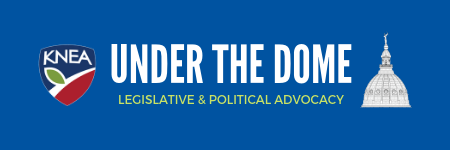Jesse Levin of the American Institutes for Research appeared before a joint session of the House K-12 Education Budget Committee and the Senate Select Committee on School Finance to release and discuss his peer review of the cost study conducted this year by Dr. Lori Taylor and Jason Willis of WestED.
Levin had earlier this session conducted a peer review of prior cost studies; one done by Augenblick and Myers and another by the Legislative Post Audit Division. Levin generally panned the A&M studies as not meeting research standards and lauded the LPA study.
We would imagine that the hiring of Levin to conduct a peer review of the Taylor study as insurance in case that study was not in line with their wishes. The Taylor study found that Kansas schools were dramatically underfunded especially given the standards they are expected to achieve.
What Levin reported today was that the Taylor study was generally a very good study that met academic rigor.
The general impression I have of the study by Taylor et al. (2018) is that it represents a quality piece of work which has been thought through and implemented carefully. Specifically, the work demonstrates a rigorous implementation of a stochastic cost frontier analysis to investigate the cost of providing educational adequacy in Kansas. Moreover, the results of the study tell a qualitatively similar story to that of the previous cost function study. (page 12)
Levin did share a few concerns he had about the report. One of the most interesting ones he shared was regarding how economies of scale were applied – the study indicated that some exceptionally large districts would require 1.97 more funding than the optimally sized districts – essentially twice as much funding.
He noted that the Taylor study called for significantly more funding than the earlier LPA study but said that the LPA study seriously underestimated the amount of funding needed because it was based on spending levels rather than costs.
In a nutshell, the Levin peer review determined that the Taylor study was done well and confirmed what earlier studies had said about school funding.
Click here to read the peer review.
Click here to see Levin’s powerpoint presentation.
Elusive Constitutional Amendment is Released
We’ve heard a lot about a desire by conservatives to apparently hold any school finance bill hostage to the passage of a constitutional amendment. Constitutional amendments have surfaced year after year beginning with the Montoy decisions.
Today a new rumored constitutional amendment was introduced in the House.
The constitution currently reads:
The Legislature shall make suitable provision for finance of the educational interests of the state.
This would be changed to read:
As all political power is inherent in the people, the legislature shall determine suitable provision for finance of the educational interests of the state. The determination of the total amount of funding that constitutes suitable provision for finance of the education interests of the state is exclusively a legislative power and shall be made as provided by law. Such power is committed to the legislature under article 2 of this constitution and shall be shown due respect by the other branches of government. No court, or other tribunal established by this constitution or otherwise by law shall alter, amdne, repeal or otherwise abrogate such power, nor shall such power be exercised by, either directly or indirectly, by any such court or other tribunal. (New language in bold.)
Under this proposal, the legislature would no longer have the obligation to provide suitable funding only to determine what it is. One assumes they would provide it but hey, who knows? Further, the language also asserts that no one but the Legislature can make the determination – so much for seeking expert opinions!
Make no mistake, this constitutional amendment is intended to diminish school funding.
It must be first approved by 84 members of the House and 27 members of the Senate; then sent for a vote of the people which requires a simple majority.


